 At Addgene we're continually impressed with the amazing plasmid technologies developed by our community of depositors. With over 40,000 plasmids avaliable in the repository, we can't give all of them attention they righlty deserve, but, in this post, we'll provide a small sampling of the many amazing new plasmid tools that have come through our doors in 2015. Do you have a favorite new plasmid tool from the past year? Let us know about it in the comments or shoot us an e-mail at blog@addgene.org and maybe we can write a blog post about it!
At Addgene we're continually impressed with the amazing plasmid technologies developed by our community of depositors. With over 40,000 plasmids avaliable in the repository, we can't give all of them attention they righlty deserve, but, in this post, we'll provide a small sampling of the many amazing new plasmid tools that have come through our doors in 2015. Do you have a favorite new plasmid tool from the past year? Let us know about it in the comments or shoot us an e-mail at blog@addgene.org and maybe we can write a blog post about it!

Split Cas9 system
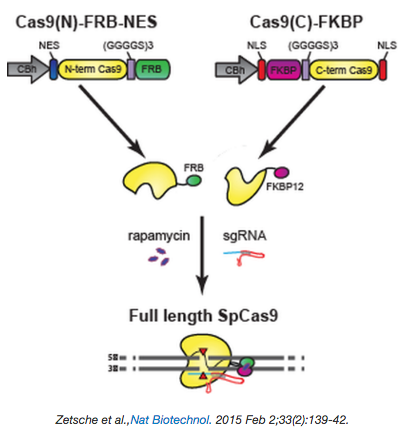 The Cas9 protein is composed of an n-terminal DNA recognition domain and a mostly c-terminal nuclease domain. Feng Zhang's group utilized the bi-lobed architecture of Cas9 to engineer a series of "split" cas9 molecules that cannot function in isolation but form a fully functional Cas9 upon dimerization.
The Cas9 protein is composed of an n-terminal DNA recognition domain and a mostly c-terminal nuclease domain. Feng Zhang's group utilized the bi-lobed architecture of Cas9 to engineer a series of "split" cas9 molecules that cannot function in isolation but form a fully functional Cas9 upon dimerization.
Splitting wild-type Cas9 into n-terminal (Cas9(N)-2xNLS) and c-terminal (Cas9(C)-2xNLS) fragments facilitates target DNA cleavage upon co-expression and spontaneous self-assembly. In an effort to obtain even more precise temporal control of gene knockout or activation, the c-terminal cas9 fragment was fused with FK 506 binding protein 12 (Cas9(C)-FKBP-2xNLS) and the n-terminal cas9 fragment with FKBP rapamycin binding domain of mTor (Cas9(N)-FRB-NES) resulting in a rapamycin-inducible Cas9 for genome editing. Without rapamycin treatment, the Cas9(N)-FRB-NES fragment is actively shuttled out of the nucleus due to the nuclear export sequence. Treatment with rapamycin induces Cas9(N)-FRB-NES and Cas9(C)-FKBP-2xNLS dimerization and net influx into the nucleus, where the functional Cas9 molecule can cleave the target DNA. The inducible split cas9 approach can also be used for activation of specific genes using dCas9-VP64 activator fragments (dCas9(C)-FKBP-2xNLS-VP64 and dCas9(N)-FRB-NES). This system provides users greater temporal control over CRISPR/Cas9 mediated genome modification and gene expression.
The plasmids associated with this article can be obtained through Addgene:
- Rapamycin-inducible Cas9 sets (Addgene plasmids 62883 &62884; 62885 & 62886)
- Rapamycin-inducible dCas9-VP64 activator set (Addgene plasmids 62887 & 62888)
-
Zetsche et al., Nat Biotechnol. 2015 Feb 2;33(2):139-42. doi: 10.1038/nbt.3149.
Light-inducible CRISPR-Cas9 system for endogenous gene activation
Optogenetics is a powerful tool that utilizes light to control and monitor individual living cells in order to understand how they work. Light activation allows scientists to spatially and temporally control which genes are turned on or off in a given area and the can do so in a very specific, precise manner. Previously, scientists have been successful in regulating gene transcription using DNA-guided optogenetic tools; however, targeting the necessary light-activated protein domains to the appropriate locus has been cumbersome.
To overcome many of the limitations intrinsic to DNA-guided systems such as TAL effectors or Zinc Finger Nucleases, the Gersbach lab has modified the RNA-guided CRISPR-Cas9 system to create a tool that is quick, versatile, and robust. Dubbed the LACE system for light-activated CRISPR-Cas9 effector, Polstein and Gersbach fused the light-inducible protein domains CibN and Cry2 to inactive dCas9 and VP64, respectively. CibN and Cry2 form a heterodimer in response to blue light, which will ultimately co-localize the VP64 transactivator with a dCas9 that has been targeted to a very specific site on the genome via the CRISPR system. The ease and flexibility of the LACE technology makes this system widely accessible for many potential applications.
-
Polstein LR & Gersbach CA, Nat Chem Biol 2015 Mar;11(3):198-200.
SunTag system for single molecule imaging and inducible gene expression
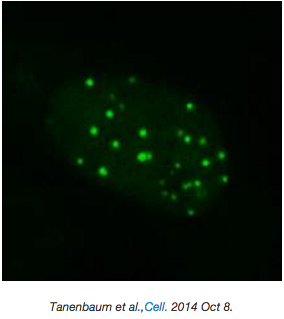 Brilliant technologies adopt basic biological concepts and employ them in creative and innovative ways. The principle of protein multimerization is seen in many important biological contexts, such as the enhancement of transcriptional activation via binding of multiple copies of a transcription factor to a promoter and localization of a protein via the presence of multiple copies of targeting sequences. Scientists have adopted and employed this concept in both imaging and inducible gene expression studies, which are evinced by the Tet system and visualization of single molecules via targeted fluorescent molecules. The Vale lab and the Weissman lab have teamed up and advanced technology in the fields of single molecule imaging and inducible gene expression by creating the SunTag system.
Brilliant technologies adopt basic biological concepts and employ them in creative and innovative ways. The principle of protein multimerization is seen in many important biological contexts, such as the enhancement of transcriptional activation via binding of multiple copies of a transcription factor to a promoter and localization of a protein via the presence of multiple copies of targeting sequences. Scientists have adopted and employed this concept in both imaging and inducible gene expression studies, which are evinced by the Tet system and visualization of single molecules via targeted fluorescent molecules. The Vale lab and the Weissman lab have teamed up and advanced technology in the fields of single molecule imaging and inducible gene expression by creating the SunTag system.
The SunTag system, named after the "stellar explosion SUperNova", is a synthetic scaffold that recruits up to 24 copies of a protein to a target polypeptide. Multimerization in the SunTag system occurs via antibody-peptide labeling; specifically, cognate peptide epitopes fused to the protein of interest are recognized and thus fluorescently labeled by scFv antibodies fused to sfGFP. This system amplifies the intensity of fluorescence signal and enables tracking of single molecules within living cells without affecting protein function, thereby creating a single-molecule reporter of intracellular processes. Multimerization via the SunTag system also shows strong upregulation of gene activation when fused to dCas9. In the dCas9-SunTag-VP64 system, dCas9 is fused to a scaffold containing epitopes recognized by scFV antibodies fused to VP64 transcriptional activation domains. This system enabled the specific recruitment of multiple copies of VP64 to the sgRNA-targeted gene, resulting in increased activation of endogenous transcription of the target gene.
The brilliant SunTag system plasmids are available through Addgene and are already very popular. Use these plasmids to increase the brilliance of your fluorescent signal and endogenous activation of your target gene!
-
Tanenbaum et al., Cell. 2014 Oct 8. pii: S0092-8674(14)01227-6.
Multi-bit genetic memory
One of the goals of synthetic biology is to engineer cells capable of recording permanent "memories" of molecular events. These memories would be recorded in the cell's DNA under the right conditions, and could initiate specified cellular processes or be observed at a later time via DNA sequencing or other readout. Cellular memory is accomplished by the use of sequence-specific enzymes (e.g. nucleases, recombinases) which irreversibly excise or invert a specific chunk of DNA. However, a limitation to this strategy is that each "bit" of information must be controlled independently; that is, the signal to record one bit of information must not act on any of the other bits in order to achieve accurate and reliable multi-bit memory.
To this end, Chris Voigt and colleagues at the MIT Synthetic Biology Center have deposited a set of 11 phage integrases which act irreversibly on their cognate attB/attP sites with no cross-talk. These pairs are closely related to the lambda phage integrase system which is the basis for Gateway cloning. The combination of all 11 att pairs in series with unique spacer sequences (pMemoryArray) gives a DNA sequence capable of recording 11 bits (1.375 bytes) of information. This leads to 2048 (211) possible combinations of states. Each of the integrases is supplied on its own expression plasmid or in various combinations, while the cognate att sites are supplied as individual reporter constructs or as the fully assembled pMemoryArray.
- Yang et al., Nat Methods 2014 Dec;11(12):1261-6. doi: 10.1038/nmeth.3147.
Bioluminescent pH sensor
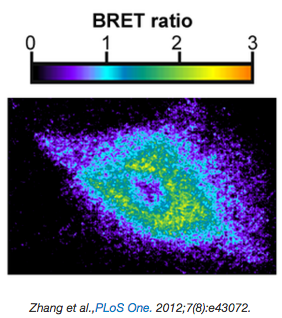 Understanding intracellular pH regulation is important as pH regulation has roles in many cellular functions, from endosomal trafficking to signaling pathways to the cell cycle. Good tools for measuring intracellular pH are required in order to determine the relationships between pH changes and cellular events.
Understanding intracellular pH regulation is important as pH regulation has roles in many cellular functions, from endosomal trafficking to signaling pathways to the cell cycle. Good tools for measuring intracellular pH are required in order to determine the relationships between pH changes and cellular events.
To overcome the issues with fluorescent pH sensors, a set of luciferase-fluorophore pH fusion reporters, pRSETb-pHlash and pcDNA3.1+-pHlash, that use Bioluminescence Resonance Energy Transfer (BRET) were developed by the Johnson Lab .
Characteristics of the pHlash reporter protein include:
- H+ specific response
- cytoplasmic retention
- insensitivity to other ions
In BRET, A mutant Renilla luciferase, catalyzes the oxidation of its substrate, luciferin, which releases energy as a photon. The photon energy is transferred to the acceptor fluorophore, a circularly permuted Venus. In the case of pHlash, the signal from the fluorophore is pH-dependent. Signal is simultaneously acquired from the the fluorescent and luminescent siganls and a ratio is calculated (the BRET ratio), which allows for compensation of varying fusion protein expression levels.
-
Zhang et al., PLoS One. 2012;7(8):e43072. doi: 10.1371/journal.pone.0043072.
Photoswitchable tools for spatial and temporal control of cell events
Three years ago, Brian Kuhlman’s lab designed photoswitchable dimers by fusing the SsrA peptide with the light-sensitive LOV2 domain of Avena Sativa phototropin 1 (AsLOV2). In the dark, this peptide is caged by the asLOV2 domain and has reduced affinity for its binding target, SspB. In the light, the Jα helix of the asLOV2 domain unfolds allowing it to bind to SspB. This original Light Inducible Dimer (oLID) could be used to modulate biological processes, but it did not show large changes in binding affinity with light stimulation. Indeed oLID showed only a two-fold change in affinity for SspB1.
In order to create a more powerful LID, the authors recently used computational protein design, phage display and high throughput binding assays, to engineer photoswitchable dimers which show over a 50 fold change in binding affinity with light stimulation2. The Kuhlman lab created two improved Light Inducible Dimers (iLID), iLID nano and iLID micro, which differ from each other by their light/dark affinity range (130nM to 4.7µM for iLID nano and 800nM to 47µM for iLID micro; Figure 1). With this great affinity range, these LIDs have been shown to be useful tools for light-mediated subcellular localization in mammalian cell culture and reversible control of signalling pathways.
These LIDs are generalizable, versatile and powerful tools which allow you to easily and reversibly switch off and on your favourite signalling pathways (Figure 2). They are all available now at Addgene.
-
1 Lungu et al., Chem Biol. 2012 Apr 20;19(4):507-17. 10.1016/j.chembiol.2012.02.006.
-
2 Guntas et al., Proc Natl Acad Sci USA 2015 Jan 6; 112(1):112-7. doi: 10.1073/pnas.
CRISPR-Cas9 optogenetic tool for activating endogenous genes
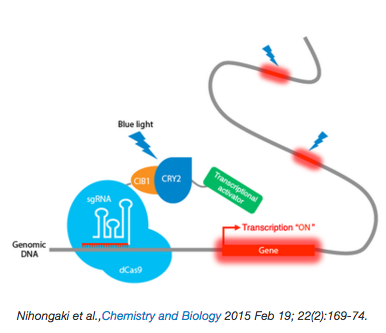 Moritoshi Sato's Lab has engineered CRISPR-Cas9 to create a photoactivatable transcription system. The tool allows scientists to use light to spatially and temporally control endogenous gene activation.
Moritoshi Sato's Lab has engineered CRISPR-Cas9 to create a photoactivatable transcription system. The tool allows scientists to use light to spatially and temporally control endogenous gene activation.
This system works by bringing together an anchor protein and activator protein to drive transcription. The anchor consists of dCas9 fused to CIB1 and is targeted to specific genes via user-defined guide RNAs. Upon stimulation with blue light, the complex recruits a CIB1 binding protein (a portion of CRY2) fused to the p65 activation domain, which activates transcription of downstream genes.
Nihongaki et al describe the targeted activation of endogenous genes and detail the time course of gene activation using this system in the article cited below. Scientists can obtain dCas9-trCIB1, CRY2PHR-p65, and other plasmids from this article through Addgene.
-
Nihongaki et al., Chemistry and Biology. 2015 Feb 19; 22(2):169-74.
High efficiency cloning for enzyme screening
Dr. David Ackerley’s lab at the University of Wellington, Victoria, has developed an adaptable bacterial expression vector which gives close to 100% cloning efficiency and gene expression. The pUCXKT vector ensures that all screened plasmids contain a gene variant* and is amenable to both high and low throughput screening applications. The system can be readily modified to use different antibiotic resistances, restriction enzymes and plasmid backbones.
pUCXKT contains a nonfunctional truncated version of the kanamycin resistance gene (missing the first two codons). Two stop codons are inserted between the truncated gene and the promoter to prevent leaky expression of this resistance. Unlike previous systems, pUCXKT does not result in a translational fusion of the antibiotic cassette to the gene of interest. The gene to be expressed is amplified using a gene-specific forward primer containing the desired restriction site (the MCS has several options) and a pUCX-specific reverse primer containing the missing codons from the antibiotic resistance cassette, a ribosome binding site, SacI restriction site and a linker region. The PCR product is then ligated into the MCS/SacI site in pUCXKT, removing the stop codons during backbone digestion and providing the missing codons for functional antibiotic resistance. Colonies with an insert in pUCXKT will therefore have resistance to both kanamycin and ampicillin (from the pUC19 backbone).
*False positives can occur in this system if a small contaminating PCR product formed from primer dimers and containing the missing codons from the antibiotic resistance gene is inserted. It is important that primers be designed to minimize the possibility of dimer formation.
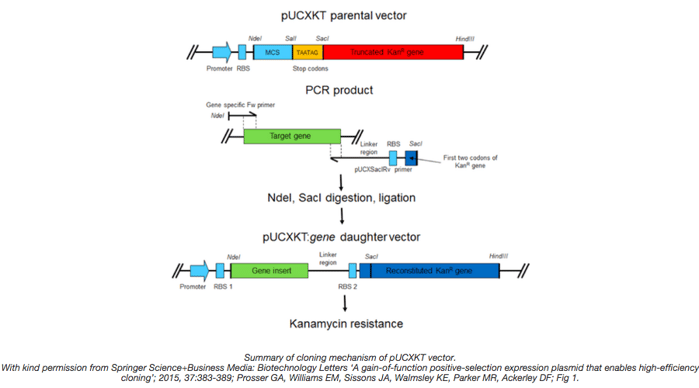
- Prosser et al., Biotechnol Lett. 2015. 37:383-389.
Toolkit for constructing fusion proteins with customizable N- and C-terminal modules
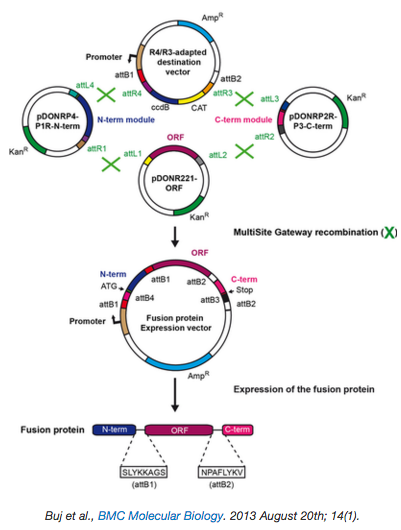 Thanks to the lab of Tomás Santalucía, you can now take any open reading frame (ORF) and with a simple recombination reaction, generate a protein with cell specific expression containing a variety of N- and C- terminal tags. The Santalucía Lab has developed a cloning toolkit based on the Multisite Gateway® technology from Life Technologies.
Thanks to the lab of Tomás Santalucía, you can now take any open reading frame (ORF) and with a simple recombination reaction, generate a protein with cell specific expression containing a variety of N- and C- terminal tags. The Santalucía Lab has developed a cloning toolkit based on the Multisite Gateway® technology from Life Technologies.The MultiSite Gateway Kit is a customizable Gateway®-based toolkit that allows scientists to generate fusion proteins from any ORF available as a standard entry clone. ORFs from an ORFeome Gateway library or any PCR-amplified ORF cloned into pDONR221 can be expressed either without a tag or as multiple fusions with different N- and C-terminal tags. Additionally, by using an adapted destination vector with a heterologous promoter outside of the Multisite Gateway® cassette, you can specifically express your new chimeric protein in a variety of model systems.
The MultiSite Gateway Kit contains a set of 12 promoter-less Gateway® entry clones to be used with other entry clones encoding the ORFs of interest:
-
Buj et al., BMC Molecular Biology. 2013 August 20th; 14(1).
TRICK: A method for visualizing the first round of translation in living cells
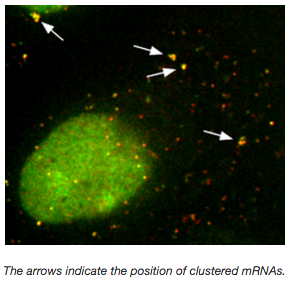 A novel technique developed in the labs of Jeffrey Chao, Robert Singer, and Anne Ephrussi allows researchers to observe when and where translation occurs in both live cells and whole animals. The system utilizes the bulldozer-like quality of the ribosome during translation, which knocks off all mRNA binding proteins as it travels along the mRNA to produce the protein product. The system, cleverly termed TRICK, for Translation RNA Imaging by Coat protein Knock-off, is made up of three components:
A novel technique developed in the labs of Jeffrey Chao, Robert Singer, and Anne Ephrussi allows researchers to observe when and where translation occurs in both live cells and whole animals. The system utilizes the bulldozer-like quality of the ribosome during translation, which knocks off all mRNA binding proteins as it travels along the mRNA to produce the protein product. The system, cleverly termed TRICK, for Translation RNA Imaging by Coat protein Knock-off, is made up of three components:
- a GFP protein that binds to the coding region of a reporter mRNA via a PP7 coat protein (NLS-PCP-GFP)
- a RFP protein that binds to the 3’ UTR of the reporter mRNA via an MS2 coat protein (NLS-MS2-RFP)
- the reporter mRNA, which contains the tethering sites for the fluorescent proteins and an inducible promoter (Plasmid 64543or 64542)
When the reporter mRNA is first transcribed, it is bound by both the GFP and the RFP proteins in the nucleus. During the first round of translation, the GFP proteins that are bound to the coding region are displaced and do not rebind because they are transported back to the nucleus (thanks to a NLS on these proteins). The RFP proteins, however, remain bound to the mRNA since they are tethered AFTER the stop codon. Thus a non-translated mRNA will appear yellow, but a translated mRNA will be red. This system achieves great specificity and resolution by using 6-12 phage PP7 coat protein binding sites and 24 copies of the MS2 bacteriophage coat protein binding sites to tether many copies of the FP-coat protein fusions to their reporter mRNAs. Using the TRICK plasmids, Halstead et al demonstrated that 91% of reporter mRNAs were untranslated in the nucleus, confirming the hypothesis that most mRNAs are not translated until they are exported to the cytoplasm. Furthermore, they find that during stress, mRNAs in P-bodies are translationally repressed whereas the nonsequestered pool goes on to initiate translation. These TRICK plasmids provide valuable tools for studying translation in living cells.
-
Halstead, et al. Science. 2015 Mar 20;347(6228):1367-671. doi: 10.1126/science.aaa3380
MuLE vectors for customized lentivirus production
Finding a lentiviral vector backbone with just the right combination of promoter, cloning sites, fusion proteins or tags and reporter genes can be nearly impossible. Fortunately, a collection of plasmids comprising the multiple lentiviral expression (MuLE) system from the laboratory of Ian Frew simplifies the process of creating complex polycistronic lentiviruses.
The MuLE toolbox contains a series of building-block vectors that are combined in a specified order using Multisite Gateway cloning. A desired insert is cloned using traditional restriction enzyme cloning to create an Entry vector containing a promoter for constitutive (CMV, SV40, SFFV) or inducible (CMV-TO) cDNA expression, sgRNA (U6) expression, shRNA/shRNA-miR30 constitutive (H1, U6, 7SK) or inducible shRNA-miR30 (CMV-TO) expression, or a promoterless construct. Pre-constructed Entry vectors containing Cas9, EGFP, mCherry, iRFP, tdTomato, luciferase, LacZ, puromycin or CreERT2 can be combined with custom-cloned vectors in a Multisite Gateway reaction with a desired destination vector expressing a separate reporter gene (EGFP, iRFP, IFP1.4, puromycin, neomycin or luciferase) to create a final lentiviral vector containing up to 5 different elements.
Lentiviral vectors constructed with the MuLE toolbox have been used for a variety of experimental purposes including (1) single or multiple, constitutive or inducible, gene knockdown with shRNA or shRNA-miR30, (2) tamoxifen-inducible CreERT2 gene deletion, (3) simultaneous expression of cDNAs and shRNAs with a reporter gene, or (4) multiple sgRNAs with Cas9 for genome engineering. The versatility and ease of generating complex combinations of genetic elements in a single lentiviral vector provides a powerful tool to modify mammalian cells.
Multicolor CRISPR labeling chromosomal loci in genome
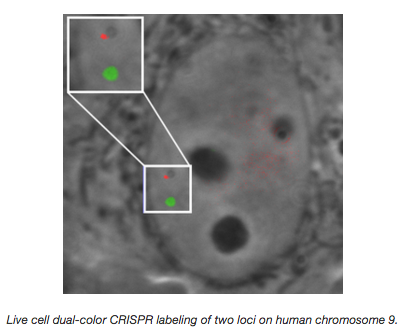 Thoru Pederson’s lab at the University of Massachusetts Medical School has recently developed a CRISPR-based multicolor tool enabling the imaging of multiple endogenous genomic loci simultaneously in live cells. This system allows the study of loci proximity and of the dynamic interactions between intra- and inter-chromosomal domains. The authors anticipate that this tool can also be used to visualize translocations, genome rearrangements and cancer-associated chromosome shattering.
Thoru Pederson’s lab at the University of Massachusetts Medical School has recently developed a CRISPR-based multicolor tool enabling the imaging of multiple endogenous genomic loci simultaneously in live cells. This system allows the study of loci proximity and of the dynamic interactions between intra- and inter-chromosomal domains. The authors anticipate that this tool can also be used to visualize translocations, genome rearrangements and cancer-associated chromosome shattering.
This method is based on the recognition of genomic loci by three orthogonal nuclease-inactive Cas9's (dCas9) from S. pyogenes, N. meningitidis and S. thermophilus which have been used for gene editing in human cells without cross-talk in cognate sgRNA binding. By fusing these dCas9s with one of three fluorescent proteins (GFP, BFP and mCherry), the authors were able to visualize simultaneously several parts of the genome and to determine, for instance, the intra-nuclear distance between loci on different chromosomes.
The advantage of having this kind of system that works in live cells is that one can now follow movement of two or more targeted loci during the cell cycle or cell differentiation. This tool should delight anyone interested in understanding the spatio-temporal regulation of human genes. The plasmids are all available at Addgene ready to light up the genome of your favorite cells.
-
Ma et al., Proc Natl Acad Sci U S A. 2015 Mar 10;112(10):3002-7. doi: 10.1073/pnas.1420024112. Epub 2015 Feb 23.
A novel dCas9 activator capable of unprecedented activation of target genes
A group of researchers headed by the Church Lab at the Wyss Institute have extended the transactivating capabilities of CRISPR/dCas9-fusion proteins and have made their dCas9 transactivators available through Addgene.
The development of dCas9 and dCas9-fusion proteins has dramatically increased the potential applications of CRISPR/Cas9 in genome-engineering. One particularly attractive application involves using dCas9-activator fusion proteins to induce endogenous gene expression. Several studies have utilized dCas9 fused to a VP64 activator domain and targeted toward endogenous promoters to activate transcription. Chavez et al. 2015 extended upon these findings by screening for additional activation domains that increase the expression of target genes when fused to dCas9. One surprising finding was that, although three of the additional domains tested (VP64, p65, and Rta) were capable of increasing target gene expression, adding all three domains onto dCas9 to generate a dCas9-VP64-p65-Rta fusion protein (referred to as dCas9-VPR) had a synergistic effect on target gene activation.
The novel dCas9-VPR activator is capable of enhancing target gene expression anywhere from 87x to 20,000x over endogenous expression (depending on the specific gene) and induction routinely reaches levels 20-40x greater than the original dCas9-VP64 activator. They also revealed that dCas9-VPR mediated gene activation is capable of promoting induced-pluripotent stem cells (iPSCs) to take on a “neuron-like” phenotype when targeting genes involved in neurogenesis, which had proven challenging using the existing dCas9-VP64 activator. The dCas9-VPR activation plasmids have great potential and have been adapted for use in mammalian cells, yeast, and Drosophila.
Synchronization of secretory protein traffic in mammalian cells
The journey of secretory proteins, from their synthesis in the ER to their arrival in their target compartment (e.g. the plasma membrane, the extracellular space, or the lysosomes) can take many paths. Understanding how a protein traffics through these pathways is key to understanding, and potentially perturbing, its function. In order to dissect protein traffic in different systems, Franck Perez’s lab, from the Institut Curie in Paris, has developed the retention using selecting hooks (RUSH) system.
How does it work? RUSH is an ingenious two-state assay based on the reversible interaction between a hook protein stably localized in the donor compartment (e.g. the ER) and a reporter protein of interest (Figure A). Franck Perez’s lab has engineered hook proteins fused to a streptavidin core that are able to retain reporter proteins fused to the streptavidin-binding peptide (SBP). The addition of biotin disrupts this interaction and thus triggers a synchronous release of the reporters which can then be tracked along the secretory pathway (Figure B). The RUSH system has already been used to study transport characteristics of various Golgi and plasma membrane reporters as well as secretory proteins or proteins targeted to membrane sub-domains. It has also been used to observe intra- and post-Golgi segregation of cargo during their transport. Finally, the system can be adapted to cellular screening to identify molecules that can perturb protein transport.
Franck Perez’s lab has developed a whole collection of hook and reporter proteins that can be used to test diverse secretory routes in various conditions. The plasmids and lentiviral vectors encoding these proteins can also be used with your own reporters to decipher their trafficking routes. This collection is now available at Addgene, so on your marks...get set...RUSH.
- Boncompain et al., Nat Methods 2012. Mar 11;9(5):493-8.
MXS cloning platform for imaging and flow cytometry applications
Designing customized fluorescent reporters can be challenging enough, but incorporating multiple reporters into a single expression plasmid using traditional cloning strategies may seem preposterous. Luckily, the Pierre Neveu laboratory designed a new iterative, chaining-based cloning method that simplifies the process of constructing specialized fluorescent reporter plasmids with MXS-chaining.
Analogous to modular assembly methods, such as BioBricks, the MXS-chaining method uses specified restriction enzyme sites to combine two modules via compatible overhangs produced by the enzymes, such that the ligation regenerates the original restriction sites for further iterative cloning steps and the joined modules cannot be separated again by the same cloning enzymes. MXS (MluI-XhoI-SalI) chaining results in a translatable ligation scar (Val-Glu) between each module to permit easy construction of fusion proteins. These three enzymes were chosen because they cut human and mouse coding regions infrequently; any MluI, XhoI or SalI sites must be removed by site-directed mutagenesis in order to use the module as a building block for further chaining.
The MXS-chaining kit contains 5 empty chaining vectors plus a destination vector and a collection of building blocks including 14 different fluorescent proteins, 8 constitutive promoters, 2 includible promoters, 3 polyA terminators and various pieces for inducible expression, loxP sites, H2B, P2A or PEST2D sequences. Several pre-constructed promoter-selection marker or promoter-inducible expression related vectors are also ready for further chaining.
Plasmids constructed using MXS-chaining were used in a variety of experiments including subcellular visualization of 6 different organelles, a cell cycle indicator for mouse embryonic stem cells and a series of inducible promoter constructs. Up to 34 building blocks were used to construct 20kb long inserts. The easily reusable MXS-building blocks are particularly effective at generating plasmids with varying numbers of repeated sequences or inserts, which can be advantageous for imaging or flow cytometry experiments.
- Sladitschek HL and Neveu PA. PLoS One. 2015. Apr 24;10(4):e0124958.
LOC8-ing mitochondrial fusion with a new tri-chromatic assay
Georg Ramm’s lab at Monash University has developed a unique tool for studying mitochondrial fusion using UV light to differentially photo-label multiple mitochondrial populations within the same cell. Mitochondrial fusion is typically assayed in living cells by using mitochondrially-targeted photoactivatable fluorescent proteins (FPs). A subpopulation of mitochondria is selectively labeled by irradiating the photoactivatable FP, then the overlap between labeled and unlabeled mitochondria, indicative of mitochondrial fusion, is quantified. This strategy relies on the current range of mitochondrially targeted photoactivatable and photoswitchable FPs that are activated by UV light (300-400nm) and that fluoresce in the green (500-550nm) and red (570-620nm) portions of the spectrum.
PhD student Benjamin S. Padman recently developed a mitochondrially-targeted variant of PSmOrange, a photoswitchable fluorescent protein which transitions from emitting orange (λ= 565nm) to far-red (λ= 662nm) fluorescence after exposure to blue-light (480nm). He also created an improved synthetic modular version of the COX8 leader sequence called Leader Of Cox8 Repeated (LOC8R) to more accurately target the mitochondria. The synthetic LOC8R sequence enhances mitochondrial targeting of PSmOrange, as well as other photoactivatable proteins like PAGFP. Co-expression of LOC8R-PSmOrange and LOC8R-PAGFP provides a novel strategy for assaying the dynamics of different mitochondrial subpopulations within the same cell; by photoswitching PSmOrange and photoactivating PAGFP in separate subpopulations of mitochondria, one can monitor how the two separate populations move and interact over time. A Ramm lab plasmid with an N1-vector-compatible LOC8R sequence is also available, N1-LOC8R.
- These plasmids are unpublished
Unnatural amino acid incorporation in mammalian cells
Peter Schultz and colleagues at the Scripps Research Institute have deposited a pair of plasmids for the cotranslational incorporation of unnatural amino acids (UAAs) into proteins in mammalian cells. Each tRNA/aminoacyl-tRNA synthase pair is encoded on a single plasmid and facilitates the incorporation of a variety of bio-orthogonal UAAs via a re-assigned stop codon (TAG). This polyspecificity enables the site-specific introduction of many different functional groups, including reactive groups for conjugation reactions, fluorescent amino acids, posttranslationally modified amino acids, photoaffinity probes, and more, to your protein of interest using the same vector system. The tRNA/aaRS pairs are delivered via a pseudotyped baculovirus system, which is advantageous compared to other viral systems due to its large cargo capacity, minimal cytotoxicity, and broad host-tropism. These tools open up many powerful avenues through which one can examine molecular events with exceptional precision in a native context.

- Chatterjee A et al. Proc Natl Acad Sci U S A. 2013 Jul 16;110(29):11803-8.
Plasmid tools for all-optical electrophysiology
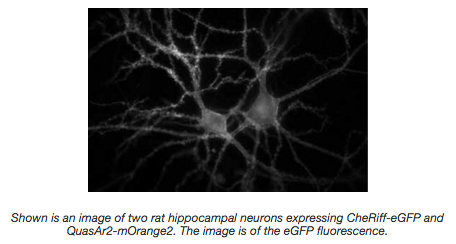 A major challenge in the field of all-optical electrophysiology is designing the perfect voltage indicator and optogenetic actuator pair. Ideally, indicators should possess fast voltage sensing kinetics and have no spectral overlap with the optogenetic actuator. In 2012, Adam Cohen's lab presented Archaerhodopsin 3 (Arch) as a new rhodopsin based voltage indicator for use in the detection of neuronal action potentials. The Cohen lab wished to improve on the Arch indicator and their collaborators in Robert Campbell’s lab carried out five rounds of random mutagenesis on a library of Arch mutants screening for improved brightness. The brightest mutants were then further mutagenized and screened for speed and voltage sensitivity. This hierarchical screen led to the generation of two enhanced voltage indicators: QuasAr1 and QuasAr2 (quality superior to Arch). Both QuasAr1 and QuasAr2 possess mutations for improved voltage sensitivity and speed, and an endoplasmic reticulum export motif and trafficking sequence for improved targeting to the plasma membrane.
A major challenge in the field of all-optical electrophysiology is designing the perfect voltage indicator and optogenetic actuator pair. Ideally, indicators should possess fast voltage sensing kinetics and have no spectral overlap with the optogenetic actuator. In 2012, Adam Cohen's lab presented Archaerhodopsin 3 (Arch) as a new rhodopsin based voltage indicator for use in the detection of neuronal action potentials. The Cohen lab wished to improve on the Arch indicator and their collaborators in Robert Campbell’s lab carried out five rounds of random mutagenesis on a library of Arch mutants screening for improved brightness. The brightest mutants were then further mutagenized and screened for speed and voltage sensitivity. This hierarchical screen led to the generation of two enhanced voltage indicators: QuasAr1 and QuasAr2 (quality superior to Arch). Both QuasAr1 and QuasAr2 possess mutations for improved voltage sensitivity and speed, and an endoplasmic reticulum export motif and trafficking sequence for improved targeting to the plasma membrane.To obtain a more sensitive channelrhodopsin actuator for triggering action potentials at low light intensities, the Cohen lab further modified sdChr- a blue-shifted channelrhodpson from freshwater green alga identified by Ed Boyden’s lab. The enhanced sdChr construct, named CheRiff, exhibits high light sensitivity and fast kinetics. By combining both the voltage indicator, QuasAr, and actuator, CheRiff, in the bicistronic Optopatch vector, the Cohen lab has provided the field with an improved tool for electrophysiology, minus the use of electrodes. The Cohen lab has made the original Arch indicator (pJMK004), as well as the CheRiff, QuasAr, and Optopatch vectors available to the scientific community through Addgene.
-
Hochbaum, et al. Nat Methods. 2014.
-
Kralj, et al. Nat Methods. 2011.
High-throughput luciferase reporter system for detection of pre-mRNA splicing
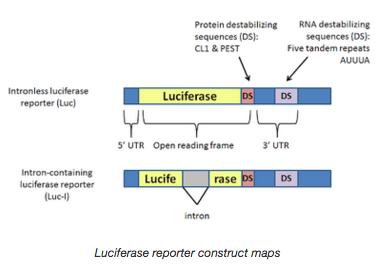 The Gideon Dreyfuss lab has developed rapid-response luciferase (firefly P. pyralis) reporter plasmids for use in high-throughput screening of pre-mRNA splicing. This reporter system can be used for identifying previously unknown factors and pathways involved in pre-mRNA splicing in a compound screen.
The Gideon Dreyfuss lab has developed rapid-response luciferase (firefly P. pyralis) reporter plasmids for use in high-throughput screening of pre-mRNA splicing. This reporter system can be used for identifying previously unknown factors and pathways involved in pre-mRNA splicing in a compound screen.Their reporter system is comprised of two plasmids: Luc (intronless; CMV-LUC2CP/ARE and Luc-I (intron-containing; CMV-LUC2CP/intron/ARE). The Luc-I intron is a chimeric β-globin/immunoglobulin intron that has been commonly used in constitutive splicing studies and has been optimized for high efficiency splicing. If intron splicing does not occur in Luc-I, the produced luciferase is truncated and lacks enzymatic activity. The Luc plasmid (intronless) is useful for counter-screening, i.e. to filter out any compounds that are affecting other global cell processes, like translation.
This luciferase reporter system was also designed for a short screening time (<4 hours) in order to avoid complicating effects from global toxicity due to loss of splicing. To this end, destabilizing sequences were added to shorten the half-life of both the luciferase mRNA (3’UTR AUUUA [5 consecutive]) and protein (C-terminal CL1 & PEST). These modifications ensure that any signal from full-length luciferase produced prior to the start of the screen is quickly removed. This system should help researchers further elucidate the many factors that affect alternative splicing in mammalian cells.
-
Younis, et al. Mol Cell Biol. 2010 Apr;30(7):1718-28.
New and improved light-switchable bacterial TCSs
Jeffrey Tabor's lab has developed new synthetic biology tools by engineering light-switchable sensors developed from bacterial two-component signal transduction systems (TCSs). TCSs are utilized by bacteria to sense and respond to their environment - typically through a histidine kinase, which triggers phosphorylation of the response regulator and downstream transcription activation or repression. The TCS light sensors described in ACS Synthetic Biology (2014) represent the newest versions of both a red- and a green-light switchable bacterial TCS system that has been improved through engineering efforts over the years. The authors optimized these systems by: 1) decreasing the number of plasmids required for each input/output system; 2) removing all chemically inducible promoters; 3) improving the strength of the promoters used; and 4) optimizing expression of both the light sensor and the response regulator. These changes reduced system leakiness and increased the dynamic range, resulting in more user-friendly and tunable tools for controlling gene expression.
For more details about these light-switchable TCSs, read our blog post: Synthetic Photobiology: Optogenetics for E. coli.
-
Schmidl, et al. ACS Synth Biol. 2014 Nov 21;3(11):820-31.
Inncredible new tools for epitope tagging: Inntags
Georgieva et al developed the inntags via a bioinformatics screen for proteins with known structure and characteristics favorable for innocuous tags including high solubility, limited affinity for other proteins, ordered structures, and accessibility to an antibody. After identifying possible protein domains containing these properties, they generated monoclonal antibodies against them, fused them to GFP, and compared them to popularly used epitopes tags such as HA and MYC in vivo. The authors found that fusions to one particular tag, the IT6 tag, interacted with fewer other proteins, had fewer effects on yeast cell viability, had less of an effect on GFP diffusion, properly localized in mammalian cells without aggregation, and were successfully used in such techniques as western blots, immunoprecipitation, and immunofluorescence.
Marti Aldea's lab has graciously made IT6 and other inntags available through Addgene so you can try these incredible new tools yourself! The tags can be found in the pBluescript II SK+ vector here.
For more information on inntags, read our recent blog post.
- Georgieva, et al. Nature Methods. 2015 Aug 31.
CRISPR-Display: A novel CRISPR technology for targeting RNA cargos to specific DNA loci
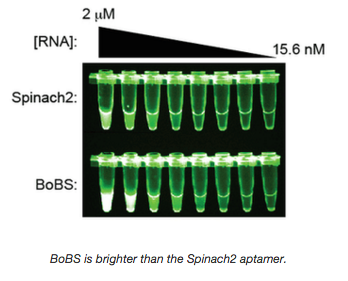 John Rinn’s lab is interested in understanding the role of long noncoding RNAs (lncRNAs) in human health and disease. A primary question in their quest to understand lncRNAs: What can lncRNAs do by themselves? The Rinn lab has developed a novel technique, called CRISPR-Display, that may help answer this difficult question. CRISPR-Display uses the dCas9 enzyme to deploy large RNA cargos to specific DNA loci. In CRISPR-Display, your RNA of interest is fused to an sgRNA used to direct Cas9 to a specific genomic locus. When fused to the sgRNA and co-expressed with dCas9 – the dCas9, sgRNA/RNA cargo complex localizes to the sequence targeted by the sgRNA. This allows scientists to target RNA-based protein-binding cassettes, artificial aptamers, pools of random RNA sequences, and natural lncRNAs to specific locations in the genome. Furthermore, these different RNA-based functions can be multiplexed using a shared pool of dCas9.
John Rinn’s lab is interested in understanding the role of long noncoding RNAs (lncRNAs) in human health and disease. A primary question in their quest to understand lncRNAs: What can lncRNAs do by themselves? The Rinn lab has developed a novel technique, called CRISPR-Display, that may help answer this difficult question. CRISPR-Display uses the dCas9 enzyme to deploy large RNA cargos to specific DNA loci. In CRISPR-Display, your RNA of interest is fused to an sgRNA used to direct Cas9 to a specific genomic locus. When fused to the sgRNA and co-expressed with dCas9 – the dCas9, sgRNA/RNA cargo complex localizes to the sequence targeted by the sgRNA. This allows scientists to target RNA-based protein-binding cassettes, artificial aptamers, pools of random RNA sequences, and natural lncRNAs to specific locations in the genome. Furthermore, these different RNA-based functions can be multiplexed using a shared pool of dCas9.To show that their sgRNA-RNA fusions were functional, Shechner et al used the constructs in their study to target various RNA molecules - such as MS2 stem loops, PPL stem loops, the Spinach2 aptamer, and more - to sequences on a Gaussia luciferase reporter vector. dCas9 or dCas9-VP64 (a control that is known to enhance gene expression) were then cotransfected with these constructs, providing the machinery that brings the sgRNA/cargo RNA to the appropriate DNA locus. The sgRNA/RNA fusions retained their appropriate functions affecting luciferase reporter expression as anticipated. For instance, an aptamer designed to bind a transcriptional activator activated gene expression from the reporter construct. The sgRNA targeting Gaussia luciferase can be easily replaced with an sgRNA targeting your sequence of choice. Many of the available sgRNA-cargo constructs utilize a U6 promoter and contain the RNA cargo cassette inserted within the sgRNA core (ie an INT construct), as the authors found that, in many situations, this was the ideal promoter/location combination. However, other constructs which contain different promoters and/or allow for insertion at the 5′ or 3′ end of the sgRNA (i.e. TOP1 or TOP2 constructs; see Supplementary Note 3 in the article for more info) are available. Furthermore, there is a general purpose cloning vector pU6_(Gluc)_INT(GenPurpClon) which can accept a novel RNA sequence of interest within the INT location. One plasmid to make note of is the INT construct bearing the "Bunch of Baby Spinach"aptamer, which is a brighter version of Spinach2, an RNA aptamer that fluoresces upon binding of a cell-permeable dye. Bunch of Baby Spinach, or BoBS, consists of three tandem copies of the Baby Spinach core embedded in a single, extended stem-loop, contiguous with the sgRNA core (see image above).
-
Shechner, et al. Nat Methods. 2015. PubMed PMID: 26030444
Fluorescent fusion proteins for understanding cellular dynamics
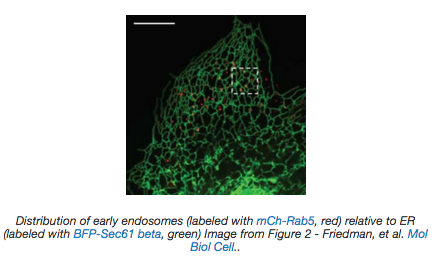 The Voeltz Lab has deposited several new fluorescent protein fusions that can be used for monitoring cellular dynamics. These fusion proteins have been used as subcellular markers to visualize the dynamics and interactions between the endoplasmic reticulum (ER), mitochondria, cytoskeleton, and endosomes. These fusion proteins can act as markers for visualization of subcellular structure, for performing live-cell imaging experiments (e.g. fluorescence recovery after photobleaching [FRAP]) for studying membrane dynamics, for monitoring cargo trafficking, and for discovering organelle contact sites.
The Voeltz Lab has deposited several new fluorescent protein fusions that can be used for monitoring cellular dynamics. These fusion proteins have been used as subcellular markers to visualize the dynamics and interactions between the endoplasmic reticulum (ER), mitochondria, cytoskeleton, and endosomes. These fusion proteins can act as markers for visualization of subcellular structure, for performing live-cell imaging experiments (e.g. fluorescence recovery after photobleaching [FRAP]) for studying membrane dynamics, for monitoring cargo trafficking, and for discovering organelle contact sites.
This suite of deposited fluorescent fusion proteins can visualize:
| Cell Structure | Plasmids: | Cell Structure | Plasmids: |
|---|---|---|---|
| ER |
|
Microtubules | |
| Early Endosome |
|
Mitochondria |
|
| Late Endosome |
-
Friedman, et al. J Cell Biol. 2010. PubMed PMID: 20696706
-
Friedman, et al. Science. 2011. PubMed PMID: 21885730
-
Friedman, et al. Mol Biol Cell. 2013. PubMed PMID: 23389631
-
Rowland, et al. Cell. 2014. PubMed PMID: 25416943
-
Shibata, et al. J Biol Chem. 2008. PubMed PMID: 18442980
-
Zurek, et al. Traffic. 2011. PubMed PMID: 20955502
CRISPR tagging techniques for studying protein interactions in their endogenous context
- Dalvai, et al. Cell reports. 2015. PubMed PMID: 26456817.
Nano-lanterns for multicolor luminescence imaging
Fluorescent imaging techniques have become indispensable tools for molecular and cell biologists over the last two decades, but their use is sometimes limited by the drawbacks of autofluoresence and photobleaching, as well as the need for external light activation. In order to overcome these limitations, Takeharu Nagai and colleagues at Osaka University have developed two new color variants of their Nano-lantern technology, first developed in 2012. The new cyan and orange Nano-lantern fusions are designed to complement the original yellow variant, with all 3 having distinct emission spectra suitable for single cell, multi-color imaging. The Nano-lanterns rely on the principle of bioluminescence resonance energy transfer (BRET), whereby photons emitted by a Renilla luciferase variant are used to excite a fused fluorescent protein, eliminating the need for an excitation light source. Instead, coelenterazine is supplied to the culture media as a chemical substrate for Renilla luciferase. This approach is especially suited to complement the use of optogenetic tools, where light used for excitation can cause unintended activation of the optogenetic system. In their 2015 PNAS manuscript, Takai et al validate the Nano-lantern approach as a tool for monitoring multi-gene expression and adapt it for multi-color calcium sensing (plasmids coming soon!).
-
Takai, et al. PNAS. 2015. PubMed PMID: 25831507.
-
Saito, et al. Nat Commun. 2012. PubMed PMID: 23232392
Testing your cell-free expression system: There’s a kit for that!
Cell-free expression systems have been improved for both eukaryotic and prokaryotic expression in recent years, with many different systems now available. However, it can be difficult to compare their performance, as most translation initiation sequences are optimised for a particular system. The Alexandrov lab at the University of Queensland’s Institute for Molecular Bioscience has provided a solution for this problem by developing a general translation initiation sequence known as the Species-Independent Translational Sequence (SITS). This sequence bypasses the 5′ mRNA cap required for eukaryotic systems and instead directly engages the ribosome for translational complex assembly. PhD student Dejan Gagoski then used SITS to create the pCell-Free vectors, Gateway-compatible backbones which enable cell-free expression of proteins in both prokaryotic and eukaryotic cell extracts (Gagoski et al 2015). He has also constructed a library of eGFP-tagged human ORF clones to allow testing and comparison of different cell-free expression systems; the Cell-free expression test kit represents a set of 88 clones in a pCellFree vector that enables protein expression in any in vitro translation system. The gene set was carefully chosen to perform statistically relevant benchmarking of cell-free expression systems, and tested for product integrity, expression level, and aggregation propensity in four expression systems: E. coli, wheat germ, HeLa, and Leishmania (Gagoski, et al 2015[2]). The proteins encoded in this set range in size from 4 to 156 kDa, enabling the user to characterise the efficiency of their cell-free system in correlation to the size of the product. Analysis of protein size and expression level can be conveniently performed through the N-terminal eGFP tag carried on all constructs.
pXPG: An alternative to the widely used luciferase reporter gene plasmid pGL3
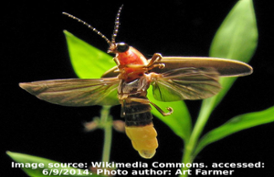 pGL3 luciferase reporter gene plasmids have been used extensively by many labs to study promoter regulation in live cells since their introduction by Sherf and Woods in the nineties. However, reliance on pGL3 has not been without problems due to the high rate of read-through transcription originating from cryptic promoters in the plasmid backbone (Giannaks et al 2003, Bert et al 2000). In 2000, Peter Cockerill and his lab developed an improved luciferase reporter gene plasmid, pXPG, which shows lower background expression than pGL3, enabling its use for the study of promoters with either weak or high activities (Bert, et al. 2000).
pGL3 luciferase reporter gene plasmids have been used extensively by many labs to study promoter regulation in live cells since their introduction by Sherf and Woods in the nineties. However, reliance on pGL3 has not been without problems due to the high rate of read-through transcription originating from cryptic promoters in the plasmid backbone (Giannaks et al 2003, Bert et al 2000). In 2000, Peter Cockerill and his lab developed an improved luciferase reporter gene plasmid, pXPG, which shows lower background expression than pGL3, enabling its use for the study of promoters with either weak or high activities (Bert, et al. 2000).
To design pXPG, the authors incorporated a high-copy origin of replication and a modified luciferase gene into a pXP1-derived vector that more efficiently blocks read-through transcription in eukaryotic cells. pXPG contains the Luc+ luciferase gene derived from pGL3 but has a distinct advantage over the latter plasmid as it contains a duplicated SV40 polyadenylation region instead of the synthetic polyadenylation signal present in pGL3. This appears to contribute to more efficient blocking of read-through transcription for pXPG. The other advantage of pXPG over pXP1 is that its new origin of replication increases plasmid copy number in E. coli. The authors used pXPG to study the human GM-CSF promoter and enhancer, a finely regulated promoter controlled by a mixture of transcription factors and chromatin remodeling events, demonstrating the utility of the pXPG construct in understanding complex gene regulation (Bert et al 2000, Johnson et al 2004).
So if you are looking for a luciferase reporter plasmid that provides a more sensitive means of studying promoter function, pXPG is an excellent choice. And guess what? pXPG is now available at Addgene.
-
Sherf, et al. 1994. Promega Notes Mag.
-
Giannakis, et al. BioTechniques. 2003. PubMed PMID: 12951775
-
Bert, et al. Plasmid. 2000. PubMed PMID: 10964627
-
Johnson, et al. Mol Cell Biol. 2004. PubMed PMID: 15340054
Imaging RNA in bacterial and mammalian cells with Broccoli
Vegetable tags, including Spinach, Spinach2, and Broccoli, can benefit your RNA experiments in several ways. The laboratory of Samie Jaffrey describes using these tags in an in-gel RNA visualization technique with RNA derived from bacterial and mammalian cells. Broccoli is an RNA aptamer that acts as a GFP mimetic and induces fluorescence in the presence of DHFBI, a small molecule fluorophore. When fused to an RNA of interest, Broccoli-DHFBI fluorescence can be used to visualize the fusion in vitro or in vivo. The protocol involves isolating total RNA, resolving by PAGE and then staining the gel with DHFBI to selectively visualize the Broccoli-tagged RNA. This technique is faster and less labor intensive than northern blotting.
To improve folding of the Broccoli apatamer, Filonov and colleagues engineered a new scaffold, F30, based on the Phi29 viral RNA junction motif, that increases RNA stability and avoids processing of the scaffold in mammalian cells into unexpected cleavage products. This scaffold allows insertion of two dimeric Broccoli tags (2xdBroccoli) to further enhance fluorescence of the tagged RNA. Bacterial and mammalian expression vectors for the F30-2xdBroccoli are available, as well as 5S RNA F30-2xdBroccoli fusion and pET28c-F30-Broccoli controls.
Don’t just eat more broccoli, use Broccoli tags in your experiments too!
-
Filonov, et al. Chem Biol. 2015. PubMed PMID: 26000751
Thank you for reading. You can find all of our Hot Plasmid articles on our website. We update the our Hot Plasmids articles every quarter so be sure to check in or subscribe to the blog to recieve the updates in our quarterly newsletter!
Resources on the Addgene Blog
- Read Our CRISPR 101 Posts
- Read Our Plasmids 101 Posts
- Read All of Plasmid Technology Posts
Resources at Addgene
- Browse Our Fluorescent Protein Resources
- Check out Our CRISPR Guide Page
- Browse Our Plasmid Collections
Topics: Other Plasmid Tools, Plasmids
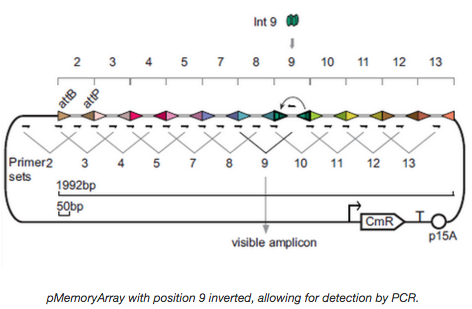

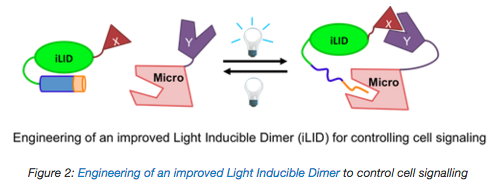
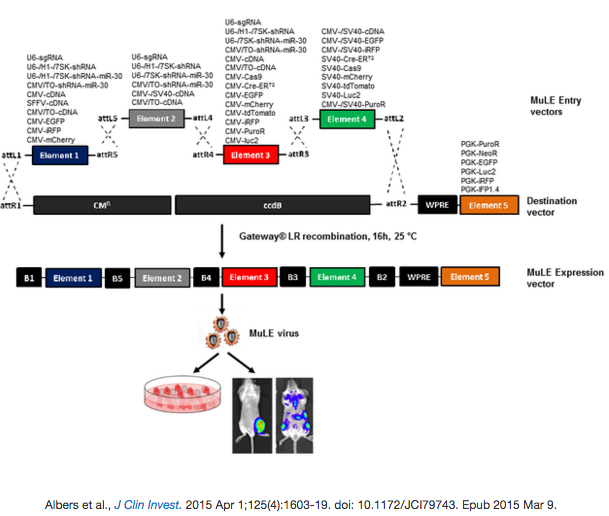
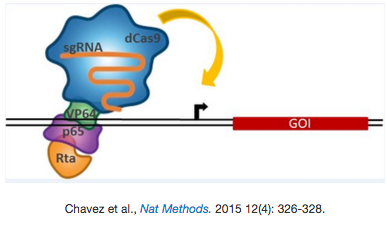
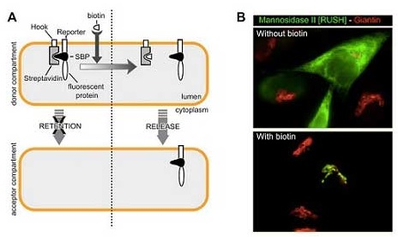


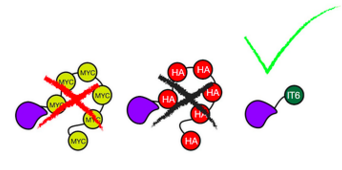
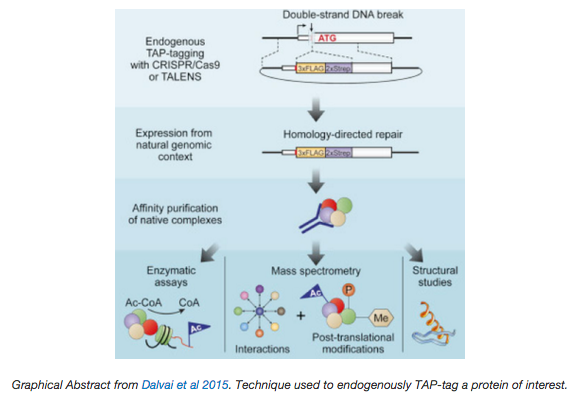
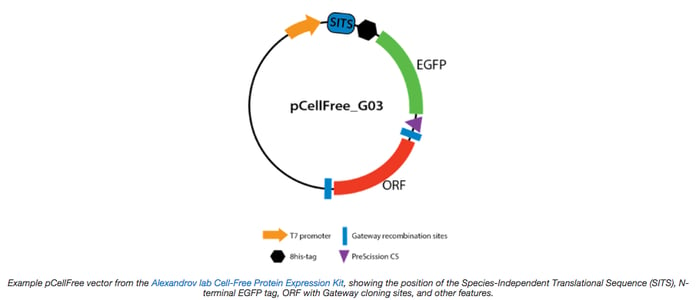
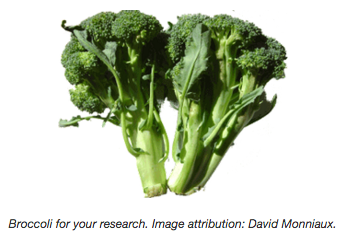





Leave a Comment